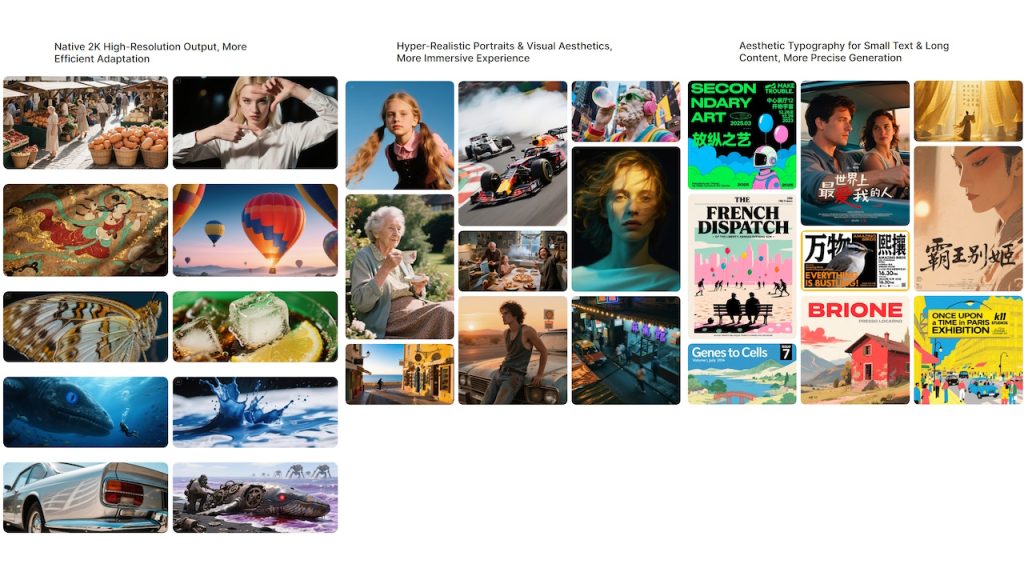ByteDance is making a concerted push into the high-end AI image generation space with Seedream 3.0, a model developed by its ByteDance Seed team. Presented as capable in both Chinese and English, Seedream 3.0 aims squarely at established names like OpenAI’s GPT-4o and Midjourney.
ByteDance materials assert the model makes substantial progress in generating photorealistic images, particularly portraits, and handling complex text rendering, while also providing native high-resolution output and faster generation times. An official technical overview and a corresponding paper outline the underlying changes.
The model began rolling out on ByteDance’s Doubao chat platform and Jimeng creation tool in early April 2025; Doubao itself is a significant distribution channel, having neared 100 million monthly active users globally by March, establishing a large potential audience primarily in China.
Advancing Text and Portrait Generation
One area where Seedream 3.0 seeks to distinguish itself is typography. The technical documentation highlights efforts to improve “fine-grained typography generation,” with advancements “in particular for text-rendering in complicated Chinese characters which is important to professional typography generation.”
This is notable for the model’s bilingual target audience, as accurate rendering, especially of complex scripts, remains a challenge for many image AIs. ByteDance claims internal tests show “a 94% text availability rate for both Chinese and English characters, effectively eliminating text rendering as a limiting factor in image generation.”
Visual comparisons provided by ByteDance suggest Seedream 3.0 manages dense text layouts, especially with Chinese fonts, more effectively than GPT-4o’s image mode (which launched its image features in late March), although OpenAI’s model also demonstrated strong text capabilities. This focus arrives as other new models, like the aggressively priced Reve Image 1.0, also compete partly on text rendering quality.
Improvements in generating realistic human portraits are also central to ByteDance’s presentation, citing “enhanced realism in portrait generation.” The objective is to produce images with more naturalistic skin features, moving away from the overly smoothed aesthetic sometimes seen in AI outputs.
User preference studies referenced by ByteDance placed Seedream 3.0 highly for portrait realism, comparing well against Midjourney’s V7 alpha (which debuted shortly before Seedream 3.0’s details emerged). Seedream 3.0’s ability to natively output images up to 2K resolution (2048×2048 pixels) is presented as a contributing factor to better texture detail, contrasting with models that rely on separate upscaling steps.
Technical Foundations And Performance Data
Several technical upgrades reportedly underpin these advancements. The training dataset size was substantially increased, partly via a “defect-aware” approach that masks minor image flaws rather than discarding the data.
Training incorporated mixed resolutions and techniques like “Cross-modality RoPE” (Rotary Position Embedding), a method that adjusts positional information based on context, intended here to improve text-image alignment. The model also uses flow matching objectives and representation alignment loss (REPA). To better match user preferences, reinforcement learning utilized large Vision-Language Models (VLMs), scaled up to over 20 billion parameters, as reward judges.
Generation speed is claimed to benefit from acceleration techniques, enabling Seedream 3.0 to produce a 1K resolution image in roughly 3 seconds, according to ByteDance. Initial benchmark results placed Seedream 3.0 near the top of the Artificial Analysis Arena user preference leaderboard around its mid-April 2025 announcement, though rankings can fluctuate.
While ByteDance’s internal tests show strong results, independent verification across diverse prompts is needed. Early user feedback noted its initial free availability and stylistic range but also launch limitations like lacking reference image input.
SeedEdit Enters The Image Editing Field
Complementing the generator is SeedEdit 1.6, a tool enabling text-prompt-based image editing, including manipulation of text within images. Officially described as built on the Seed T2I model, it competes with features integrated into ChatGPT via GPT-4o.
ByteDance suggests SeedEdit offers superior preservation of the original image’s characteristics during modifications compared to GPT-4o, particularly for complex tasks like text alteration. The SeedEdit product positioning targets professional applications in photography, art, and e-commerce. While these advancements are presented positively, achieving claimed performance often involves trade-offs, potentially including computational demands, which will become clearer with wider adoption and third-party testing.

